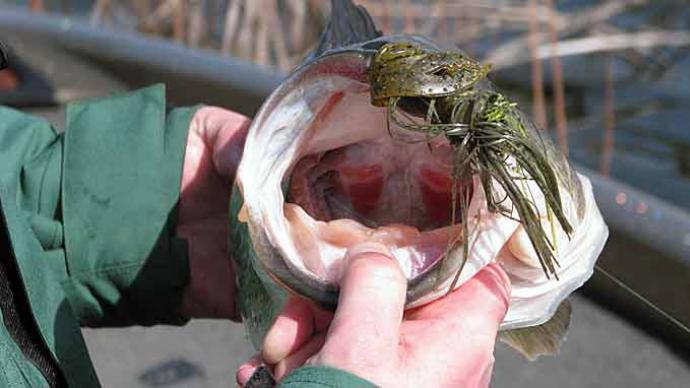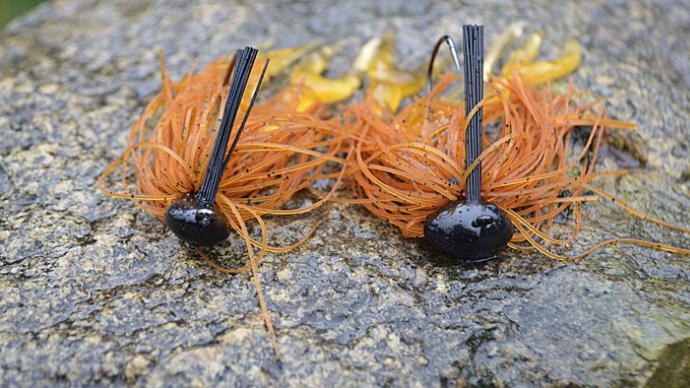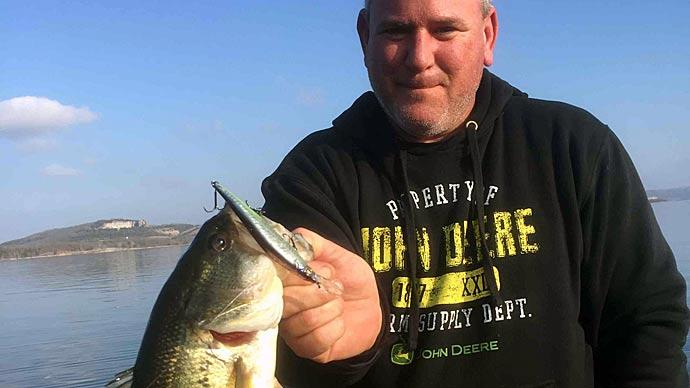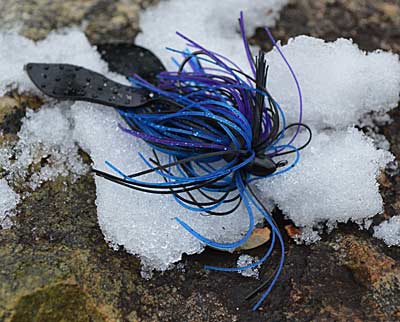
When it comes to jigs, bass anglers agree on one thing: There’s no more versatile or powerful lure, especially when it comes to consistently catching bigger than average bass. These simple combinations of head, hook, skirt, and trailer catch largemouth, smallmouth, and spotted bass. And usually, the colder the conditions, the hotter the bite.
Jigs bring plenty to the table. They represent an easy-to-eat meal to bass. Between different weights and trailers, it’s easy to adjust their rate of sink to match the bass’ current mood. They’re tied in an almost endless number of colors, so it’s easy to match the hatch or current water conditions. They’re nearly snag-proof, making them perfect for spots covered with heavy cover. And they can be fished anywhere in the water column.
But even with all their shared attributes, specific jigs work better under certain conditions. It’s no different from late winter through early spring. Here’s how to choose the best ones and fish them in the best places.
The locations
Location is paramount in real estate. Property particularly close to key infrastructure attracts the most action. It’s no different in bass fishing. You can fish all day, but your catching will be slim if you aren’t casting at spots holding bass. That’s especially true in cold water when bass are bottom-oriented.
The best cold-water spots have some type of hard cover. It’s usually rock. Large boulders attract some bass, but broken rock is better. Stretches of rip-rap, rocky points, and slides along bluffs are some of the best. Even a rock pile on a flat will attract bass in cold water.
Rocks offer a couple of benefits. First, if the water is at least somewhat clear, they absorb solar energy and release it as heat into the surrounding water. While bass won’t flock to a couple of degrees difference, it will make the ones that live there more active and willing to bite. And secondly, its cracks and crevices are home to plenty of prey, especially baitfish and crawfish. That built-in food supply means bass, whose metabolism is slowed by cold water, don’t have to summon much energy to find a meal.
Bass bask in similar benefits around wood cover. Brush piles placed in deep water, for example, attract their fair share of cold-water bass. Docks are productive, too, especially if other forms of cover are lacking, which is the case in many power-generation reservoirs. Both are better when combined.
Whether rock or wood, a cold-water spot improves with a depth change, such as a stretch of rip-rap that’s deeper than the rest, docks standing outside a channel swing, or a rock pile on the edge of a flat. Bass on these spots can quickly go deeper to seek shelter from changing weather or shallower to enjoy a warm spell without traveling a great distance. They prefer to keep their world compact, like the jigs they eat best.
The approach
Bass are opportunistic feeders. When they come across an easy meal, they grab it. While a fast and erratic retrieve will generate a few reaction strikes under perfect conditions, moving your jig with a slow and methodical retrieve will serve you better day in and day out from late winter through early spring.
Creating that easy-to-eat appearance starts with dragging. Avoid quick consecutive movements of your rod’s tip that pop your jig. Hold your rod to the side, and point its tip toward the water, making slow and steady pulls instead. That will keep your jig on or close to the bottom, where cold-water bass cling.
Let your jig soak. When it crosses a piece of brush, for example, comes around a dock post or over a rock, let it rest for 10 or 15 seconds before resuming your retrieve. That helps create a natural presentation; bass prey moves slow in cold water, too. It also allows nearby bass to mosey over, find it and bite. Make longer pauses on the coldest days, especially when the sun is bright.
The setup
Almost any jig will work in almost any situation. But matching one to the current conditions makes catching more and bigger bass easier. And in cold water, that’s a heavy jig with a compact profile that creates just enough action.
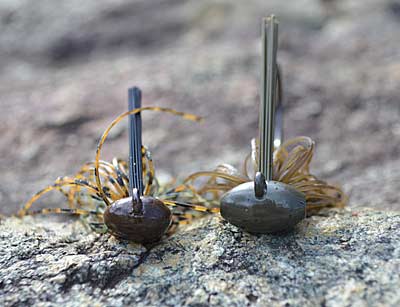
The most popular weight of jig is probably 3/8 ounce. It’s easy to cast, pitch, and flip and reaches depths where bass are often found. And if you’re patient, you can fish them through the cold-water season. But it’s easier to maintain bottom contact and a slow retrieve with one that weighs 1/2 ounce or more.
Choose a jig whose head shape compliments the additional weight and your retrieve. The all-around Arkie is a good choice, especially when your deep-water spot isn’t that deep in the grand scheme of bass fishing. A better choice is a football head. It’s easy to drag across the bottom, primarily through rock, creating an attractive rocking action. Weight is concentrated below and ahead of the line tie, so it sinks straight on a slack line, following bottom changes without planing away.
Don’t overlook your jig’s hook. While hooks made from heavy wire help boat flip bass from heavy cover, they’re difficult to set in deep water. So, look for light-wire hooks, which bite with less effort. Take your time playing and landing bass, and you’ll land nearly all the bites they hook.
Cold-water bass want an easy meal, and jigs sporting a compact profile imitate those. While the shape and size of your jig’s head is essential, it plays a small role in creating its shape. The skirt and trailer cast that.
Finesse-style jigs work anytime the bite is tough. But you don’t have to use them when the water is cold. You can enjoy the benefits of a bigger hook by trimming a full-size jig’s skirt. Shorten its length to about 1/4 inch beyond the hook, and remove a few strands to thin it. A smaller skirt brings other benefits, such as helping your jig reach deeper depths quickly and making it easy to keep it there.

Soft-plastic trailers contribute to a jig’s profile and sink rate, maybe more so than its skirt. They should mirror the skirt’s slim and trim shape when the water is cold. Small trailers like Zoom’s Super Chunk Jr. or Tiny Salty Chunk are perfect. And add 3- or 4-inch single tail grubs and craws, such as a portion of a Gene Larew Salt Craw, to the mix.
Your jig’s trailer should create minimal action, helping it to sink faster and stay close to the bottom. Its effectiveness can be maximized with scent. It’s cooked into many soft-plastic lures and can be applied in a spray or gel. You also will find it, along with subtle action, in Uncle Josh’s pork frogs, which were recently re-introduced.
Consider your rod, reel, and line, too. Fishing compact jigs slowly in deep water requires a setup different from the ones used to pound shallow-water cover in warmer temperatures. Try a 7-foot rod that has a medium-heavy power and fast action. It’ll cast heavy jigs and make subtle movements easier. Match it to a casting reel with a moderate retrieve speed, about a 6:1 gear ratio. It’ll make slower retrieves easier, keeping your jig on the bottom.
Spool your reel with braided line. Its diameter is smaller than an equal pound test monofilament or fluorocarbon line, so it has less resistance in the water. That helps get your jig to the bottom faster and stay there. Its sensitivity will alert you to the lightest bite, and its abrasion resistance will mean you’ll land those big bass that grate it across rock, wrap it around a dock post or pull it through a brush pile.
The exception
A compact heavy jig fished around hard cover in deep water will serve you well throughout the cold-water season. But as it nears its end, an opportunity for a different style of jig fishing emerges, which is equally effective.
Even though the water remains cold, longer days signal that changes are underway, and bass respond by suspending. You can catch them by fishing a jig through the water column, moving it like it was on the bottom.
This pattern doesn’t work everywhere. It’s best around boat docks, especially those that ride on black floats. Bass suspend under them, using the docks and their shadow as cover. And their dark color, which absorbs plenty of solar energy, creates slightly warmer water.
You’ll still want a compact jig because the water is relatively cold. But back off on its weight and switch to a bigger trailer. A 1/4-ounce jig, for example, with a full skirt and full-size Zoom Big Salty Chunk, creates plenty of float, keeping your offering higher in the water column for longer. Place your cast or pitch alongside a dock and give your jig enough time to sink where it disappears. Then work it like you’re fishing along the bottom, mixing slow pulls and pauses. It’s much slower than the retrieve used with a traditional swim jig, but the bites are no less dramatic. They often show as a significant jump in your line or a solid thump.
BassResource may receive a portion of revenues if you make a purchase using a link above.


